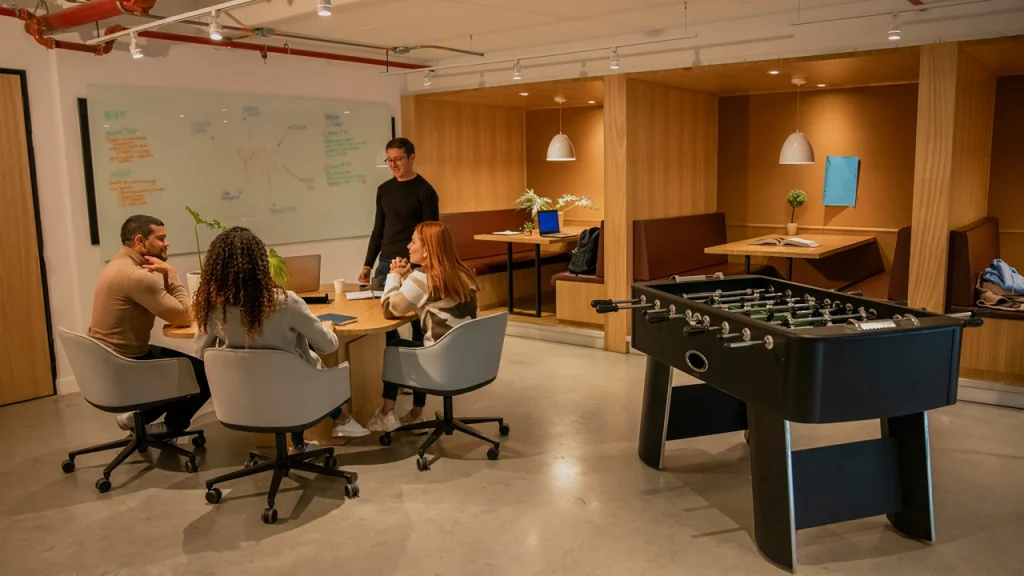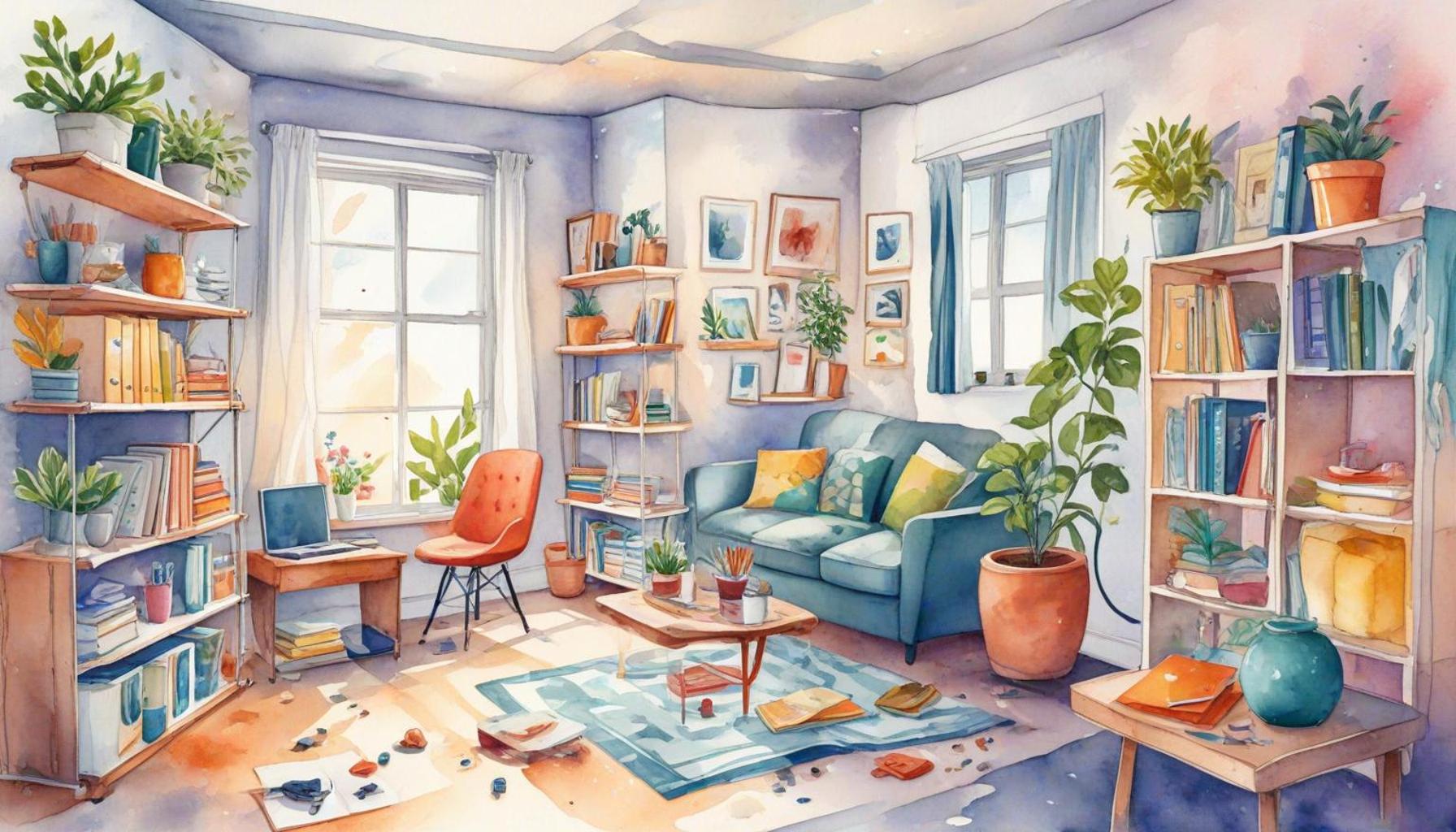Creating Functional Spaces: Tips for Organizing and Simplifying Your Work Environment

Creating Your Ideal Workspace
A well-organized work environment fosters several key attributes essential for productivity: focus, creativity, and efficiency. As distractions proliferate, maintaining a clutter-free space becomes a vital investment—not only in your work but in your overall well-being. Whether your domain is a dedicated office, a cozy corner of your living room, or a bustling coffee shop, the principles of a functional workspace remain constant and impactful.
Consider the following essential aspects when sculpting your ideal working environment:
- Decluttering: Begin with a ruthless audit of your workspace. Identify and remove items that serve no purpose or that divert your attention. For example, keep only the tools relevant to your current project on your desk. This can include a notepad, your computer, and perhaps a pen. Establish a “one in, one out” rule to prevent future clutter—if you bring something new in, let go of something old.
- Zoning: When designing your workspace, think in terms of functionality. Create designated zones for different activities. For instance, designate one area solely for computer work, another for reading or brainstorming, and perhaps a relaxation corner with a plant or artwork that inspires you. The psychological division of tasks can significantly enhance concentration and productivity.
- Storage Solutions: Effective storage is the backbone of an organized workspace. Invest in shelves, bins, and drawer organizers to sort your supplies and ensure that everything has a home. Utilize vertical space by installing floating shelves or pegboards for tools and materials, making them not only accessible but also visually appealing.
Research indicates that an organized workspace can increase productivity by as much as 30%. Such numbers underscore the potential benefits of reimagining your work environment. Consider the additional time you could have for creative thinking or personal achievements if distractions were minimized.
Diving deeper into the essentials of crafting your workspace, let’s explore some practical tips. Ergonomic furniture is critical; a chair that supports posture and a desk at the right height can play a huge role in maintaining comfort during long hours of work. Furthermore, integrating natural light into your workspace can elevate your mood and energy levels, which can lead to greater output.
In conclusion, transforming your workspace is not just about organizing; it’s about creating an ecosystem that enhances your workflow and productivity. By implementing these strategies and remaining open to new ideas, you can cultivate an environment that inspires success and satisfaction in your professional journey.

DIVE DEEPER: Click here to learn more about conscious consumption
Maximizing Efficiency through Design
When it comes to organizing your work environment, the layout plays a crucial role as it can significantly impact both productivity and comfort. A thoughtfully designed workspace not only promotes efficiency but also helps cultivate an atmosphere that inspires creativity and focus. Consider the flow of your work: how do you move through your tasks, and what adjustments can enhance this experience?
To maximize your workspace’s potential, it is essential to think about these critical design factors:
- Desk Placement: The location of your desk can influence your workflow. Ideally, position your desk in a way that allows for ample natural light without glare on your screen. A view of the outdoors—such as a garden or tree line—can provide a refreshing mental break. If possible, avoid placing your back toward the door, as this can create a sense of vulnerability.
- Ergonomics: Investing in ergonomic furniture is essential for promoting long-term health and well-being. An adjustable chair that supports your lower back and a desk that can accommodate both sitting and standing positions can help prevent discomfort and fatigue. Aim to create a work setup that aligns with your body’s natural posture.
- Aesthetic Appeal: The color scheme and decor in your workspace matter. Soft, calming colors can promote serenity and focus, while vibrant shades might stimulate creativity. Adding personal touches like artwork, motivational quotes, or photographs can create a welcoming ambiance that suits your personality and keeps you motivated.
Moreover, don’t underestimate the power of ambient factors. The right level of noise can enhance concentration. Some individuals thrive in complete silence, while others may benefit from background music or white noise. Experiment with different settings to find what environment best fuels your productivity.
Technology Integration
As workplaces evolve, technology continues to reshape how we function. Streamlining your tech setup can lead to a more efficient workflow. Clear out outdated equipment or software that no longer serves a purpose and ensure that your essential devices are within easy reach. Utilize cable management options, such as cable trays or ties, to minimize visual clutter and maintain a clean appearance.
Furthermore, consider utilizing digital tools to keep your tasks organized. Task management applications, calendar software, and collaborative platforms can help keep you on track and seamlessly coordinate with coworkers, even when working remotely. By integrating effective technological solutions, you can simplify your processes and stay organized.
In summary, embracing an organized and functional workspace goes beyond mere tidiness; it involves a holistic approach that considers design, ergonomics, and technology. By implementing these factors into your workspace strategy, you pave the way for heightened productivity and improved overall work experiences. This dedication to refining your environment can uniquely position you for success, making your daily tasks more manageable and enjoyable.
Second Part: Key Strategies for a Functional Workspace
When it comes to creating functional spaces within your work environment, the implementation of thoughtful strategies can significantly enhance both productivity and comfort. An organized workspace isn’t just aesthetically pleasing; it’s crucial for promoting a focused mindset. Below are several effective methods to simplify and optimize your work environment.
Declutter Your Space
Start by removing unnecessary items from your desk. A clutter-free workspace helps in minimizing distractions and allows for better concentration on tasks. Consider using storage solutions such as drawers, shelves, or decorative boxes to keep items that you wish to retain but don’t need immediate access to.
Utilize Vertical Space
In smaller areas, maximizing vertical space can create a more functional environment. Wall shelves, pegboards, and hanging organizers free up valuable desk space and keep essential supplies within reach. This not only helps in maintaining organization but also gives your workspace a more open feel.
Implement Zoning Techniques
Designate specific areas for different tasks. For example, create a zone for focused work, another for meetings or collaborative tasks, and a separate area for breaks. This zoning can stimulate productivity by associating certain activities with specific spaces, leading to a more efficient workflow.
Incorporate Ergonomics
Prioritize comfort by investing in ergonomic furniture. A well-chosen chair, desk, and monitor height can make a world of difference in your workday. Ensure your workspace supports good posture and reduces physical strain, allowing you to work comfortably for extended periods.
Personalize Your Environment
While organization is key, don’t forget to add personal touches that can motivate you. Whether it’s artwork, plants, or meaningful keepsakes, a workspace that reflects your personality can foster creativity and passion in your daily tasks.By focusing on these strategies for organizing and simplifying your work area, you’ll create a functional space that not only looks appealing but also enhances your productivity and well-being. Embrace the journey of transforming your work environment into a place where you can thrive.
DIVE DEEPER: Click here to discover more
Decluttering for Clarity
One of the most impactful steps you can take toward creating a functional space is embracing the art of decluttering. A tidy workspace is not merely about aesthetic appeal; it significantly influences your mental clarity and efficiency, making it easier to focus on tasks that matter. Many professionals often underestimate the direct correlation between physical clutter and mental chaos—while it may seem innocuous, a disorganized environment can lead to increased stress and distraction.
To successfully declutter your workspace, consider adopting the “one-touch” rule. This approach dictates that when you pick up an item, you should either file it away, act on it, or discard it immediately. This minimizes procrastination and prevents piles of paper from accumulating on your desk. Additionally, employing the 20/20 rule—which suggests that if you can replace an item for less than $20 or in less than 20 minutes, you should let it go—can also provide clarity during the decluttering process.
Storage Solutions
Incorporating smart storage solutions is pivotal when striving for an organized workspace. Vertical storage options, such as bookshelves or wall-mounted organizers, can help you maximize space while keeping essential items at your fingertips. Consider adding labeled boxes or baskets to categorize supplies, paperwork, or other frequently used items. This not only streamlines access but also keeps your workspace visually appealing and organized.
Another innovative option is to utilize multifunctional furniture. Desks with built-in storage or collapsible tables can provide versatility without sacrificing space or style. They not only enhance the utility of your workspace but also maintain a streamlined appearance, making it easier to maintain order. Additionally, a rolling cart can be a practical solution for on-the-go tasks, easily moved to accommodate collaborative projects or personal tasks without overtaking your space.
Creating Zones
Distinct zones within your workspace can further enhance efficiency. By segmenting your work area into dedicated spaces for different activities—such as a reading nook, a crafting corner, or a technology station—you can optimize your focus and energy levels. This spatial division helps you compartmentalize tasks, reducing fatigue and bolstering creativity. For example, placing a comfortable chair in a quiet corner with a mini-library of reference materials can encourage a productive break from the hustle of desk work.
Moreover, when creating zones, it may be beneficial to designate a specific space for relaxation. Engaging in short breaks for mindfulness or stretching can improve your overall well-being, reducing stress and increasing focus when you resume work. Introducing elements like indoor plants, a soft rug, or even a comfortable chair can create an inviting area that energizes you during the workday.
Ultimately, the key to an organized work environment lies in developing a clear strategy: declutter, invest in smart storage solutions, and create distinct zones suited to your needs. With these principles in mind, you can cultivate a workspace that not only enhances productivity but also contributes to your overall happiness and fulfillment in your professional endeavors.
DISCOVER MORE: Click here to learn about conscious consumption
Conclusion
In an era where work-life balance is paramount, the importance of a well-organized and simplified workspace cannot be overstated. By embracing the principles discussed—decluttering to achieve mental clarity, utilizing effective storage solutions, and creating functional zones tailored to your workflow—you can transform your work environment into a sanctuary of productivity. Studies suggest that a clutter-free workspace directly correlates with enhanced creativity and reduced stress. Thus, this is not merely an aesthetic endeavor but a strategic approach to improving the quality of your work life.
Moreover, consider the unique elements that resonate with your personal style and work habits. The integration of multifunctional furniture and ergonomic design, coupled with calming elements like plants, can also contribute to a healthier workspace. By fostering a sense of order and functionality, you will not only optimize your efficiency but also enhance your overall well-being.
As you embark on the journey to create a more functional space, remember that it’s an ongoing process. Periodic evaluations of your workspace and adaptability to new challenges will keep your environment aligned with your evolving needs. Take the time to reflect on what aspects of your space are working for you and what could be improved. As you implement these actionable tips, you will discover a workspace that nurtures your ambitions and supports your path to success in both your professional and personal life. So roll up your sleeves and start transforming your workspace today—you might be surprised at the positive changes that follow.


